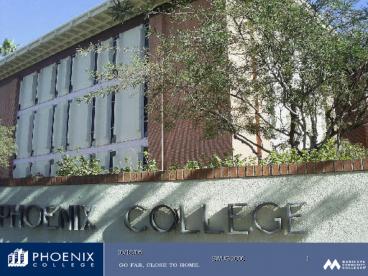Geospatial Technology for Environmental Science - PowerPoint PPT Presentation
1 / 29
Title:
Geospatial Technology for Environmental Science
Description:
Phoenix College has an occupational program in which students ... Lithosphere. Hydrosphere. Biosphere. Written report & oral presentation. 10/18/06. SWUG 2006 ... – PowerPoint PPT presentation
Number of Views:27
Avg rating:3.0/5.0
Title: Geospatial Technology for Environmental Science
1
(No Transcript)
2
(No Transcript)
3
(No Transcript)
4
Geospatial Technology for Environmental Science
- Remy Autz, Adjunct Faculty
5
Summary
- Phoenix College has an occupational program in
which students can learn GIS and remote sensing. - The following slides show
- how this came about
- what is included in the program
6
- Promised a curriculum that would lead to
certification as a Geospatial Technician - The Department of Labor
- approved this curriculum for the
- Geospatial Apprenticeship Program
7
Who is SPACESTARS?
The Partners
Supporting Team Members
8
STARS Curriculum(Spatial Technology And Remote
Sensing)
- Based on a study of workforce needs
- Roles that must be played
- Skills that are needed
- For each role, the importance of each skill
9
STARS Curriculum(Spatial Technology And Remote
Sensing)
- Maps, remote sensing, geographic relationships,
project management - ArcView 9.1 Spatial Analyst used to support
economic development decisions - ArcGIS 3D, Image, Spatial, Network Analyst
- Plan, implement, present a campus project
10
Traditional Map Interface
11
Image Map Interface
12
Remote Sensing
13
Students learn about their county with over 120
GIS data layers
14
Utilize feature image data
15
Study Digital Elevation Models
16
Create a 3D Display of Our Campus
17
Learn GIS Using Industry Standard Tools
18
Steps in Development
- No Occupational Committee
- 1st GIS course approval with BIO prefix
- Occupational Dean encouraged development of a
Geospatial Technology Program - MCCCD Innovation Grant approval
- Purchased Curriculum 65,000
- Designed and Promoted Program 25,000
19
Steps in Development
- Recruited adjunct faculty
- Faculty attended local training 6 days
- Scheduled courses one during day three in the
evening - Acquired partial use of computer lab
- Loaded additional software and training data in
computer lab - Began teaching August 21, 2006
20
Course 1 BIO119 Introduction to Geospatial
Technology for Environmental Science
- Maps and coordinate systems
- Images produced with remote sensing
- Extracting feature data from images GPS
- Adding features to a GIS data set
- Using Satellite Tool Kit to simulate planning for
image acquisition
21
Course 1 ENV119 Introduction to Geospatial
Technology for Environmental Science
- Using a GIS to explore geographic relationships
in and between - Atmosphere
- Lithosphere
- Hydrosphere
- Biosphere
- Written report oral presentation
22
Course 2 ENV219 Geospatial Technology for
Environmental Science I
- Learning to use ArcGIS 9.1
- Physical, political, transportation, land use,
and economic datasets - Analyzing and interpreting spatial data in
support of an economic development project - Base Map
- Regional Indicators
- Constraints Opportunities
- Local data available for enrichment exercises
23
Course 3 ENV273 Geospatial Technology for
Environmental Science II
- Learning to use ArcGIS 9.1 Extensions
- Network Analyst
- Spatial Analyst
- Image Analyst
- 3D Analyst
- Local data available for enrichment exercises
24
Course 4 ENV295 Geospatial Technology Projects
for Environmental Science
- Development of a campus base map
- 3D Analyst
- GPS data collection
- Project management for campus project
- Work with stakeholders
- Collect manipulate data
- Create written report and oral presentation
- Offering this course in Spring 2007
25
Certification as a Geospatial Technician
- Written report and map images must be sent to the
certifying authority - Instructor must certify that the materials
represent students independent work - Written exam is sent for local proctoring
- Exam is graded, pass/fail, by the certifying
authority.
26
Certifying Authority
- Center of Excellence in Geospatial Technologies
- 35 geospatial companies
- 3 universities
- 4 non-profit companies
27
Certification Provides
- National Recognition
- Preparation for Work in an Emerging Technology
- Foundation skills for 1000s of jobs
- Work in one of the 3 fastest growing fields
- Heightened Professional Recognition
- Greater Earning Potential
28
Value of Certification
- Met standards for entry level work
- Professional recognition
- Employer assurance
- Positive, meaningful personal identity
- Personal accountability
29
Questions?
Remy Autz 602.481.2596 Remy.autz_at_pcmail.maricopa.e
du































